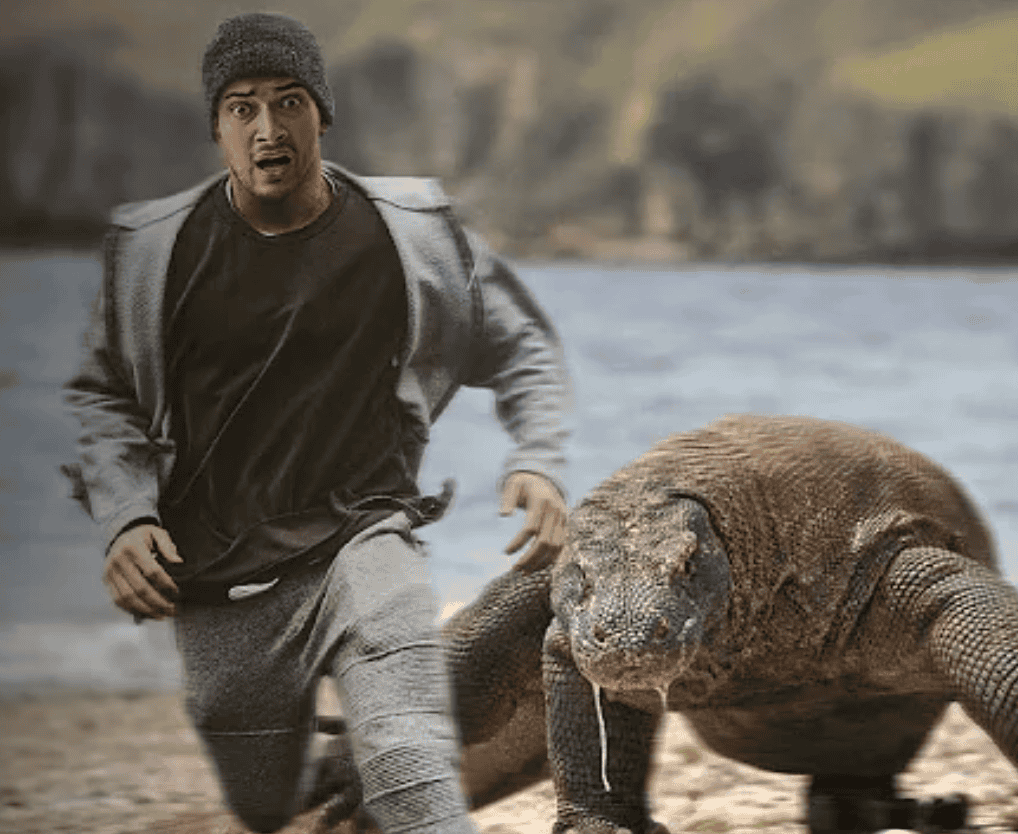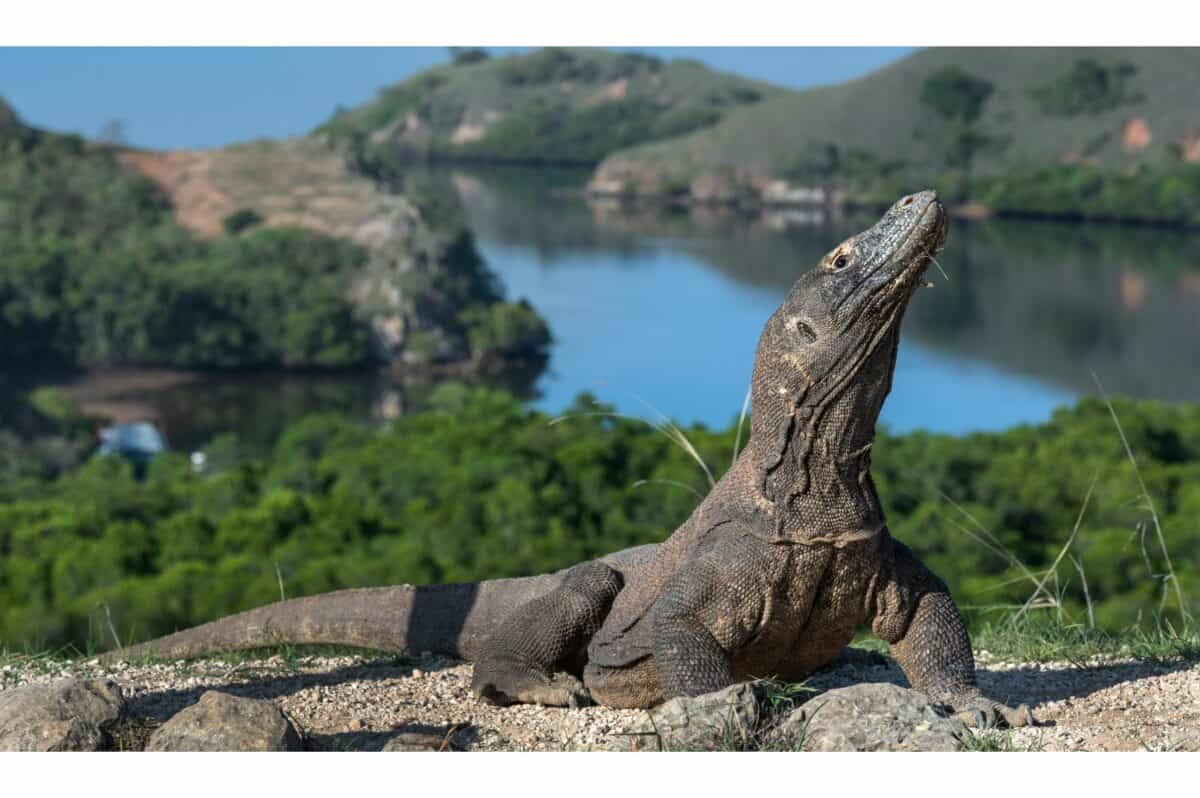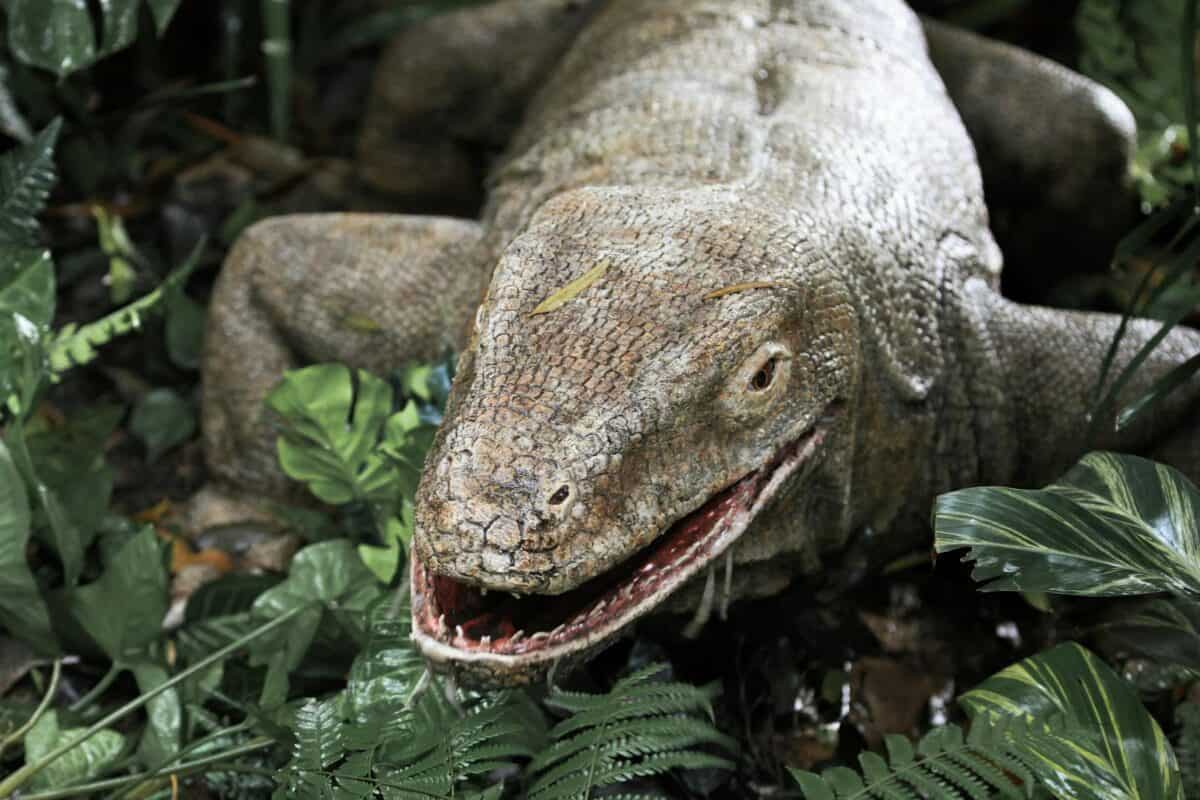Deep in the remote islands of Indonesia lurks one of nature’s most formidable predators—the Komodo dragon. These ancient reptiles have earned a fearsome reputation as the world’s largest lizards, capable of taking down prey many times their size, including water buffalo. Behind their hunting success lies a deadly combination of physical strength, hunting strategy, and a bite that delivers a potent cocktail of toxins and bacteria. While Komodo dragons have inhabited Earth for millions of years, scientists have only recently begun to fully understand the complex mechanisms that make their bite so lethal. This article explores how these magnificent apex predators have evolved to become one of nature’s most efficient hunters, with a particular focus on their devastating bite and its ability to bring down animals as large and powerful as water buffalo.
The Komodo Dragon: An Ancient Apex Predator

The Komodo dragon (Varanus komodoensis) stands as a living fossil, having evolved over millions of years into the apex predator of its island habitat. Native to the Indonesian islands of Komodo, Rinca, Flores, Gili Motang, and Padar, these massive lizards can grow up to 10 feet in length and weigh more than 300 pounds. They belong to the monitor lizard family (Varanidae) but dwarf their relatives in size and predatory capabilities. Their evolution in island isolation has created a unique predator that sits atop the food chain in its ecosystem, with no natural predators of its own. Komodo dragons can live up to 30 years in the wild, hunting and scavenging with remarkable efficiency throughout their lives. Their ancient lineage traces back approximately 4 million years, making them a valuable window into prehistoric reptilian adaptations.
The Anatomy of a Deadly Hunter

Komodo dragons possess a formidable physical structure perfectly adapted for hunting. Their muscular bodies support powerful limbs with sharp claws ideal for grasping prey. A Komodo’s tail, nearly as long as its body, serves as both a weapon and a counterbalance during movement. Their most distinctive hunting feature is their skull, which houses a sophisticated jaw mechanism and 60 serrated teeth designed to tear flesh. Unlike most reptiles, Komodo dragons have relatively large brains for their body size, contributing to complex hunting behaviors and spatial awareness. Their sensory adaptations include excellent vision, capable of detecting movement from 985 feet away, and a highly specialized olfactory system. Perhaps most unusual is their forked tongue, which collects airborne particles and transfers them to the Jacobson’s organ in the roof of their mouth, allowing them to “taste” the air and track prey from miles away—even detecting carrion from up to 5.9 miles downwind.
The Mystery of the Komodo’s Deadly Bite

For decades, scientists believed that Komodo dragons relied primarily on bacteria in their mouths to kill prey. According to this theory, dragons would bite a victim and then patiently follow it for days until septic shock from bacterial infection finally caused death. However, research in 2009 revolutionized our understanding when Bryan Fry, a biochemist at the University of Melbourne, discovered that Komodo dragons actually possess venom glands. These specialized glands produce toxins that prevent blood clotting, lower blood pressure, induce muscle paralysis, and cause shock in their victims. The combination of deep wounds from serrated teeth, venom that prevents healing and causes catastrophic blood loss, and bacterial contamination creates a three-pronged attack that few animals can survive. This discovery resolved the longstanding puzzle of how Komodo dragons could bring down such large prey relatively quickly, sometimes within hours rather than days, as the bacteria theory had suggested.
The Biomechanics of a Komodo Bite

The Komodo dragon’s bite delivers incredible force measured at approximately 39 newtons, which is significant but not exceptional in the animal kingdom. However, what makes their bite particularly devastating is the combination of this force with their unique tooth structure and jaw mechanics. Their teeth, unlike those of mammals, are serrated like steak knives and can tear flesh with remarkable efficiency. The dragon’s flexible skull, similar to that of a snake, allows it to manipulate prey in its mouth. When a Komodo bites, it employs a “grip-and-rip” technique, clamping down with its powerful jaws and then tearing backward, creating gaping wounds that bleed profusely. Research from the University of Texas has shown that Komodo dragons can exert pull forces up to 0.5 times their body weight through their necks and forelimbs when tearing at prey—meaning a 200-pound dragon can pull with a force of about 100 pounds, causing catastrophic tissue damage to its victim.
Venom: The Dragon’s Secret Weapon

Contrary to earlier beliefs, Komodo dragons possess sophisticated venom glands in their lower jaws that secrete complex proteins. These venom glands, identified by Bryan Fry and his team, produce toxins similar to those found in venomous snakes. The dragon’s venom contains over 150 different toxins, including compounds that prevent blood clotting (anticoagulants), reduce blood pressure (hypotensives), and cause muscle paralysis and shock. When injected into prey through the dragon’s bite, these toxins quickly compromise the victim’s physiological systems. The anticoagulant properties prevent wound healing and promote continuous bleeding, while the hypotensive components cause blood pressure to plummet. Additionally, substances in the venom inhibit pain responses in prey, potentially explaining why bitten animals often appear relatively calm even with serious injuries. This sophisticated chemical arsenal makes even a single bite potentially fatal to large mammals, including water buffalo, which may succumb to blood loss and shock within hours rather than days.
The Role of Bacteria in the Komodo’s Bite

While venom has been established as the primary killing mechanism, bacteria still play a significant role in the Komodo dragon’s predatory arsenal. Studies have identified over 50 bacterial strains in Komodo dragon saliva, including potentially pathogenic species like Pasteurella multocida, Staphylococcus, and Escherichia coli. These bacteria can cause severe infections in bite wounds, complicating recovery for any prey that might initially survive the venom’s effects. The bacteria appear to be both environmental (picked up from feeding on carrion) and specialized to the dragon’s oral ecosystem. Interestingly, Komodo dragons themselves seem immune to these bacteria, suggesting evolutionary adaptations in their immune system. Recent research indicates that rather than being passive carriers, Komodo dragons may actually cultivate specific oral bacteria through specialized feeding behaviors and oral maintenance. The combination of venom and pathogenic bacteria creates a remarkably efficient two-phase attack: venom for rapid incapacitation and bacteria for ensuring that escaping prey eventually succumb to infection if they survive the initial attack.
Hunting Strategies: How Komodos Take Down Buffalo

When targeting large prey like water buffalo, Komodo dragons employ sophisticated hunting strategies that showcase their intelligence and patience. They often hunt in loose groups, with multiple dragons sometimes participating in an attack on a single buffalo. The hunt typically begins with stealth—Komodo dragons can remain motionless for hours, camouflaged in the underbrush, waiting for the right moment to strike. When attacking, they target the legs and underside of the buffalo, inflicting deep wounds to hamper mobility and cause blood loss. After the initial attack, Komodo dragons will often retreat to a safe distance and follow the wounded buffalo for hours or days. This tracking behavior, known as “following the scent of death,” allows them to conserve energy while the venom and bacteria take effect. GPS tracking studies have shown that Komodo dragons can follow wounded prey for up to 2-3 days, maintaining visual or olfactory contact. Once the buffalo weakens sufficiently or dies, the dragons will feed collectively, with dominant individuals eating first in a hierarchical pattern. This coordinated hunting approach allows these relatively slow reptiles to systematically take down prey weighing up to ten times their own body weight.
The Water Buffalo: A Formidable Yet Vulnerable Prey

Water buffalo (Bubalus bubalis) are imposing creatures, weighing up to 2,000 pounds, with powerful bodies and dangerous horns that would deter most predators. Despite their size advantage, water buffalo on the Indonesian islands have become vulnerable prey for Komodo dragons due to several factors. First, many buffalo are non-native, introduced by human settlers, and lack evolved defenses against dragon attacks. Second, the limited fresh water on these arid islands forces buffalo to frequent specific water holes where dragons often ambush them. Water buffalo rely on wallowing to regulate body temperature and protect against parasites, making these predictable visits to water sources inevitable. When wounded by a Komodo dragon, buffalo typically flee to water sources, inadvertently creating ideal conditions for infection as the warm, stagnant water harbors bacteria. This behavior plays directly into the Komodo dragon’s hunting strategy—the wounded buffalo develops severe infections, weakens over days, and eventually becomes immobile enough for the dragon to deliver a killing bite. Conservation studies show that approximately 80% of buffalo attacked by Komodo dragons eventually die from the encounter, either directly or from complications of their wounds.
The Feeding Frenzy: How Komodos Consume Their Massive Prey

Once a water buffalo succumbs to a Komodo dragon’s attack, the feeding process is remarkably efficient and adapted to maximize nutritional gain. Komodo dragons can consume up to 80% of their body weight in a single feeding—meaning a 200-pound dragon might consume 160 pounds of buffalo meat. Their feeding begins with a frenzied tearing of flesh, using their serrated teeth and powerful neck muscles to rip off chunks of meat. Unlike mammalian predators, Komodo dragons don’t need to kill their prey before beginning to eat; they sometimes start consuming larger animals while they’re still alive. Their flexible skulls allow them to swallow enormous pieces of meat whole, and powerful stomach acids break down bones, hooves, and horns. After gorging themselves, Komodo dragons may not need to feed again for weeks or even months. Time-lapse photography has documented a group of dragons reducing a 400-pound buffalo carcass to scraps of hide and bone in under four hours. This feeding efficiency is crucial to their survival in the resource-limited island environments they inhabit, allowing them to capitalize on rare successful hunts of large prey.
The Evolutionary Arms Race

The predator-prey relationship between Komodo dragons and large mammals represents a fascinating case of evolutionary pressure. On the islands where Komodo dragons evolved, prey species like the now-extinct pygmy elephant (Stegodon) and local deer species developed adaptations to avoid dragon predation. Evidence suggests that some native prey species evolved behavioral adaptations such as increased vigilance and avoidance of areas where dragons typically ambush prey. However, introduced species like water buffalo lack these evolutionary adaptations, making them particularly vulnerable. Meanwhile, Komodo dragons themselves have evolved specialized hunting strategies and physiological adaptations specifically for targeting large prey. Their venom likely evolved from common toxin-producing genes found in many lizards, but became more specialized and potent through natural selection. The dragons’ ability to detect carrion from miles away, track wounded prey for days, and digest nearly all parts of a carcass all represent specialized adaptations that maximize their survival in their island ecosystem. This ongoing evolutionary arms race has shaped both predator and prey throughout thousands of generations, resulting in the formidable hunting capabilities we observe today.
Human Encounters: The Danger to People

While Komodo dragons primarily target wild prey, human attacks have occurred throughout history, though they remain relatively rare. Since 1974, there have been approximately 24 documented attacks on humans, with 5 resulting in fatalities. Most attacks occur when humans venture into dragon territory without proper precautions or when dragons, increasingly habituated to humans through tourism, associate people with food. When attacking humans, Komodo dragons typically target the legs and ankles, using the same hunting strategy they employ against natural prey. A single bite can be life-threatening due to the combination of venom, bacterial infection, and blood loss. Treatment for Komodo dragon bites requires immediate medical attention, including thorough wound cleaning, antibiotic treatment, and often antivenom therapy similar to that used for certain snake bites. Park rangers and local guides in Komodo National Park carry forked sticks to fend off potential dragon attacks, keeping the animals at a safe distance. Despite their dangerous capabilities, fatalities are uncommon because dragons generally avoid humans unless provoked or conditioned to associate them with food sources. Conservation efforts now focus on maintaining appropriate barriers between tourists and these powerful predators.
Conservation Status and Threats

The Komodo dragon is classified as an endangered species by the International Union for Conservation of Nature (IUCN), with an estimated wild population of fewer than 6,000 individuals. Their limited range—now primarily within Komodo National Park—makes them particularly vulnerable to habitat loss and human encroachment. Climate change poses an existential threat, as rising sea levels could submerge up to 30% of their lowland habitats by 2100 according to some projections. Poaching, though less common than for other endangered species, still occurs for traditional medicine and exotic pet trade markets. Tourism, while providing economic incentives for conservation, brings challenges including habitat disruption and food conditioning when dragons are fed to attract visitors. Conservation efforts include habitat protection, anti-poaching patrols, genetic diversity studies, and captive breeding programs in zoos worldwide. In 2019, Indonesian authorities temporarily closed Komodo Island to tourists to address conservation concerns, highlighting the delicate balance between ecotourism and protection. Recent conservation successes include expanded protected areas and increased local community involvement in preservation efforts, though the species remains at significant risk without continued intervention.
The Komodo dragon’s ability to take down water buffalo exemplifies nature’s remarkable evolutionary engineering. Through millions of years of adaptation, these reptiles have developed a sophisticated predatory toolkit combining physical strength, hunting intelligence, and a biochemical arsenal that few animals can withstand. The discovery of their venom glands revolutionized our understanding of these creatures, shifting our perception from simple scavengers to sophisticated apex predators with complex hunting strategies. As scientists continue to study Komodo dragons, we gain valuable insights not only into reptilian evolution but potential medical applications from their venom and bacteria-resistant immune systems. The preservation of these magnificent predators and their natural hunting behaviors represents not just a conservation priority but an opportunity to maintain one of nature’s most remarkable evolutionary achievements—a living dragon whose bite truly can bring down a buffalo.
- The Coldest Town in America—And How People Survive There - August 9, 2025
- How Some Birds “Steal” Parenting Duties From Others - August 9, 2025
- 12 Deep-Sea Creatures You Won’t Believe Exist - August 9, 2025

